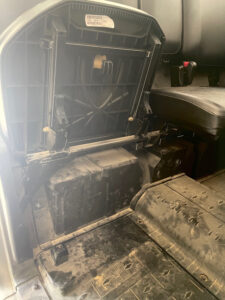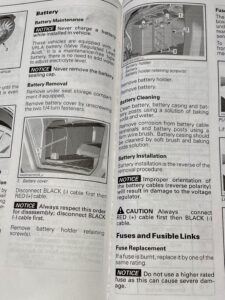
Gentle Reader, I ask you, does this photograph look like any place you would ever expect to find a battery? I do not know about you, but after many experiences changing out dead batteries in cars, pickups, lawn equipment, flashlights, etc., I never expected any semi-comatose foreign manufacturer (what other kind do we have now?) to hide the battery to my dune buggy inside the cab under a passenger seat. It probably took several committee meetings of diabolical Russian or Chinese speaking, Cal-Tech educated, overpaid engineers for them to gleefully agree upon such an inane placement.
I realize it has been 60 years since I worked at a Phillips 66 service station on Main Street in Pawhuska, Oklahoma, but I would have thought if a teenager could open a hood and locate a battery said location might have, at least, not now become hidden from common sense. By the way, it was a service station where one could get their tires aired up, their tank filled with 27¢ per gallon gas by an attendant, their oil checked and their battery replaced all for less than the cost of 10 gallons of liquid gold. Alright, it is true you could not get a rotisserie chicken or a garish faux silk screen shirt emblazoned with some supposedly witty saying your mother would get out the soap for.
Now I ask you, are not batteries supposed to be right under the hood or, with the parochial pride of the Europeans in mind, right under the trunk lid? Would any self-respecting automobile mechanic deign to pull up seats in the passenger compartment in search of a battery? I should say, not!
And if one has to search for the Holy Grail of batteries where only a lost coin or a stale cookie would be expected, could the designers of the automotive Enigma Machine have at least put a label on the cleverly camouflaged cover with a small clue as to what it was hiding? Say the word “Battery”, maybe?

I read the “Operator’s Guide” cover to cover after lifting the hood and finding nary a battery. The “Guide” is 196 pages from stem to stern and I make my living reading lots of words, including as Edgar Allen Poe might say, many a volume of forgotten lore. I am used to reading dross trying to pass for depth. However, the drivel of this manual does not pass as information much less enlightenment. The photograph contains the “Guide’s” entire instruction on battery replacement (Pages 124 and 125). I defy you to detect how the process is to proceed.
But once the battery is located and the cover is removed, the fun has just begun. I bet those Cal-Tech foreign born geniuses are still chortling over their anticipation as to how a normal sized human would surrender in frustration trying to put a screw and a nut into the space of a gnat’s nest.
Well, I am nothing if not stubborn so I refused to file a lawsuit until every knuckle I had was skinned and Peg was suggesting I just give the dune buggy to somebody we do not like. I could not think of anybody I was that mad at. Anyway, after only 3 days I got the red attached to the positive pole then the black to the negative. Of course, I had to reconstruct how the cover must be replaced. And even though I had tested the buggy’s starting before putting the gaggle of parts back together, when I got it all rearranged and was filled with self-satisfaction in my refusal to let the foreigners win, it refused to start.
It’s all good now as I have decided to follow the example of several grangerized folk artists I have noticed who have made their old vehicles into yard ornaments. When you drive by JPeg Osage Ranch, Gentle Reader, you may find a dune buggy surrounded with cacti and sandstone sporting a R.I.P. sign.

Leave a Reply